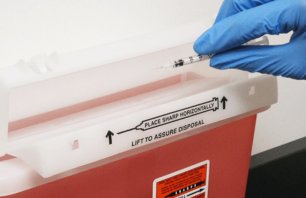Nearly two million new cases of cancer in the United States are expected in 2023, according to the American Cancer Society. While many cancer treatments are given in a hospital or clinic, some can be done at home. These treatments include oral medications (via pills, capsules, tablets, or liquids) and topical treatments (creams or ointments applied to the skin). In certain cases, even intravenous or injectable therapies can be administered at home. These treatments can involve chemotherapy, targeted therapy, immunotherapy or hormone therapy drugs.
Throughout the COVID-19 pandemic, home care services, including for patients undergoing cancer treatments, were prioritized to help alleviate staffing shortages at hospitals and other healthcare facilities. While the pandemic has waned, it accelerated the growth of at-home care, a trend that is expected to continue.
At-home care warrants diligent patient education about medication management and disposal, as many patients don’t know what to do with leftover medication. Keeping or improperly discarding this material can lead to potential diversion (unauthorized use of a medication, which could cause harm), or pollution of waterways if medications are discarded down the drain. Stericycle’s 2022 Healthcare Workplace Safety Trend Report (HWSTR) found that providers and administrators agree that the rise in at-home care makes proper medical and pharmaceutical waste disposal more challenging. Of those surveyed, 91% of healthcare providers agreed that patients need more information and resources about how to properly dispose of pharmaceutical and medical waste at home.
What Can At-Home Care Patients Do with Unused or Expired Medications?
Prior to disposal, proper management of pharmaceuticals during administration is also important. Certain drugs used to treat cancer pose risks regardless of how they are administered. Patients should take precautions to prevent others in their household from exposure to these chemicals, as they can remain in the body and bodily fluids for extended periods. According to the American Cancer Society, to maintain safety at home, patients should follow guidelines provided by their cancer care team. These include separate laundering for items contaminated with bodily fluids or treatment drugs, extra safety measures when using the toilet, proper storage of drugs away from children and pets, ensuring only the intended person handles the medication, and following spill cleanup procedures.
When ready to discard unused, expired, or otherwise unwanted medications, the United States Environmental Protection Agency (EPA) encourages individuals to utilize pharmaceutical take-back programs, which typically accept both prescription and over-the-counter medications. These programs are available at various locations, such as local law enforcement agencies and retail or hospital pharmacies.
The U.S. Drug Enforcement Administration (DEA) sponsors the National Prescription Drug Take Back Day twice per year in communities across the country. To find a local law enforcement agency that is participating in these programs, visit the DEA's website.
How Stericycle Solutions Can Help You Properly Dispose of Cancer Drugs Generated At Home
Beyond Drug Take Back Day, Stericycle works closely with hospitals, retail pharmacies, and other organizations to enable the anonymous collection of unused drugs all year. Here are some ways we help take part in the disposal of unused post-consumer medications:
- MedDropTM Medication Collection Kiosks
DEA-registered hospitals and retail pharmacies can encourage responsible drug collection with our MedDrop™ medication collection kiosks. Since its launch in 2016, the MedDropTM solution has helped our customers collect over 5 million pounds of consumer medications that could otherwise have been diverted or abused or discarded in a manner that contaminated community water supplies. Stericycle incinerates this collected material before sending it for end disposal.
MedDropTM medication collection kiosks provide a convenient way for individuals to dispose of unneeded household prescription or over-the-counter medications, helping to reduce the impact of pharmaceuticals on the environment compared to discarding down the drain.
- Seal&SendTM Consumer Medication Mail Envelopes
For those who cannot access a drug take back location, Stericycle offers our Seal&Send™ consumer medication mail envelopes. These prepaid envelopes allow patients to send up to eight ounces of unused medication to Stericycle via USPS for incineration. Unlike drug collection kiosks, which can only be hosted by certain DEA registrants, any individual or organization can purchase Seal&SendTM envelopes and provide them to patients, employees, students, and others.
We are committed to helping keep communities safe. Visit our Safe Community Solutions page for more information about Stericycle’s post-consumer pharmaceutical waste disposal solutions as well as our other medical waste services.
Frequently Asked Questions
What Is Drug Take Back Day?
National Prescription Drug Take Back Day is an initiative led by the DEA in the United States. It occurs in April and October of each year to help address the drug overdose epidemic and promote community safety and health. The DEA encourages the public to remove unneeded medications from their homes as a measure of preventing medication misuse.
The next National Prescription Drug Take Back Day will take place on October 28, 2023.
Here are some steps individuals can take to help prepare for Drug Take Back Day:
- Locate all medications in your household and ensure that they are securely stored. All lids should be tightly secured on bottles and away from the reach of children and pets.
- Conduct an inventory of the medications and identify which are unwanted and/or have expired dates.
- Clearly label medications that need disposal.
- Take the medications to a Drug Take Back Day collection site between 10:00 a.m. and 2:00 p.m.
Use the DEA collection site locator to locate the closest Drug Take Back Day collection site.
Many communities also have year-round drug take-back programs.
How Does Incineration of Pharmaceutical Waste Help Protect Waterways?
EPA endorses the incineration of pharmaceutical waste due to the potential risk for active pharmaceutical ingredients to be released into the environment as a result of other disposal methods. Incineration destroys active pharmaceutical ingredients before the material is disposed, which helps prevent discharge or leaching of those chemicals into waterways.
Stericycle incinerated 38 million pounds of pharmaceutical waste before disposal in 2022, helping to keep active pharmaceutical ingredients out of waterways.



